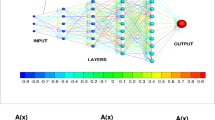Abstract
A novel hybrid method is proposed for neural network training. The method consists of two phases: in the first phase the bounds for the neural network parameters are estimated using a genetic algorithm that uses intervals as chromosomes. In the second phase a genetic algorithm is used to train the neural network inside the bounding box located by the first phase. The proposed method is tested on a series of well-known datasets from the relevant literature and the results are reported.



Similar content being viewed by others
References
Hornik K (1989) Multilayer feedforward networks are universal approximators. Neural Netw 2:359–366
Shen L, Jingheng W, Yang W (2016) Multiscale quantum mechanics/molecular mechanics simulations with neural networks. J Chem Theory Comput 12:4934–4946
Manzhos S, Dawes R, Carrington T (2015) Neural network-based approaches for building high dimensional and quantum dynamics-friendly potential energy surfaces. Int J Quantum Chem 115:1012–1020
Wei JN, Duvenaud D, Aspuru-Guzik A (2016) Neural networks for the prediction of organic chemistry reactions. ACS Central Sci 2:725–732
Falat L, Pancikova L (2015) Quantitative modelling in economics with advanced artificial neural networks. Procedia Econ Finance 34:194–201
Namazi M, Shokrolahi A (2016) Mohammad Sadeghzadeh Maharluie, Detecting and ranking cash flow risk factors via artificial neural networks technique. J Bus Res 69:1801–1806
Igor I (2016) Baskin, David Winkler and Igor V. Tetko, A renaissance of neural networks in drug discovery. Expert Opinion Drug Discov 11:785–795
Bartzatt R (2018) Prediction of novel Anti-Ebola virus compounds utilizing artificial neural network (ANN). Chem Faculty Publ 49:16–34
Rumelhart DE, Hinton GE, Williams RJ (1986) Learning representations by back-propagating errors. Nature 323:533–536
Riedmiller M, Braun H (1993) A direct adaptive method for faster backpropagation learning: the RPROP algorithm. Proc IEEE Int Conf Neural Netw 5:586–591
Robitaille B, Marcos B, Veillette M, Payre G (1996) Modified quasi-Newton methods for training neural networks. Comput Chem Eng 20:1133–1140
Leung FHF, Lam HK, Ling SH, Tam PKS (2003) Tuning of the structure and parameters of a neural network using an improved genetic algorithm. IEEE Trans Neural Netw 14:79–88
Yao X (1999) Evolving artificial neural networks. Proc IEEE 87(9):1423–1447
Zhang C, Shao H, Li Y (2000) Particle swarm optimisation for evolving artificial neural network, In: IEEE international conference on systems, man, and cybernetics, pp 2487–2490
Hansen E, Walster GW (2004) Global optimization using interval analysis. Marcel Dekker Inc., New York
Markót MC, Fernández LG, Csendes CT (2006) New interval methods for constrained global optimization. Math Program 106:287–318
Žilinskas A, Žilinskas J (2010) Interval arithmetic based optimization in nonlinear regression. Informatica 21:149–158
Michaelewicz Z (1996) Genetic Algorithms + Data Structures = Evolution Programs. Springer, Berlin
Chandra R, Dagum L, Kohr D, Maydan D, McDonald J, Menon R (2001) Parallel programming in OpenMP. Morgan Kaufmann Publishers Inc., New York
Simonoff JS (1996) Smooting methods in statistics. Springer, Berlin
Mackowiak PA, Wasserman SS, Levine MM (1992) A critical appraisal of 98.6 degrees f, the upper limit of the normal body temperature, and other legacies of Carl Reinhold August Wunderlich. J Am Med Assoc 268:1578–1580
Little MA, McSharry PE, Hunter EJ, Ramig LO (2008) Suitability of dysphonia measurements for telemonitoring of Parkinson’s disease. IEEE Trans Biomed Eng 56:1015–1022
Yeh I-C, Yang K-J, Ting T-M (2009) Knowledge discovery on RFM model using Bernoulli sequence. Expert Syst Appl 36:5866–5871
Hayes-Roth B, Hayes-Roth BF (1977) Concept learning and the recognition and classification of exemplars. J Verbal Learn Verbal Behav 16:321–338
King RD, Muggleton S, Lewis R, Sternberg MJE (1992) Proc Nat Acad Sci USA 89:11322–11326
Andrzejak RG, Lehnertz K, Mormann F, Rieke C, David P, Elger CE (2001) Indications of nonlinear deterministic and finite-dimensional structures in time series of brain electrical activity: dependence on recording region and brain state. Phys Rev E 64(6):8
Tzallas AT, Tsipouras MG, Fotiadis DI (2007) Automatic seizure detection based on time-frequency analysis and artificial neural networks. Comput Intell Neurosci 2007:13. https://doi.org/10.1155/2007/80510
Harrison D, Rubinfeld DL (1978) Hedonic prices and the demand for clean ai. J Environ Econ Manag 5:81–102
Kruskal W, Wallis W (1952) Use of ranks in one-criterion variance analysis. J Am Stat Assoc 47:583–621
Acknowledgements
The experiments of this research work was performed at the high performancecomputing system established at Knowledge and Intelligent Computing Lab-oratory, Dept of Informatics and Telecommunications, University of Ioannina,acquired with the project “Educational Laboratory equipment of TEI of Epirus” with MIS 5007094 funded by the Operational Programme “Epirus” 2014-2020,by ERDF and national finds.
Author information
Authors and Affiliations
Corresponding author
Additional information
Publisher's Note
Springer Nature remains neutral with regard to jurisdictional claims in published maps and institutional affiliations.
Rights and permissions
About this article
Cite this article
Anastasopoulos, N., Tsoulos, I.G., Karvounis, E. et al. Locate the Bounding Box of Neural Networks with Intervals. Neural Process Lett 52, 2241–2251 (2020). https://doi.org/10.1007/s11063-020-10347-z
Accepted:
Published:
Issue Date:
DOI: https://doi.org/10.1007/s11063-020-10347-z




